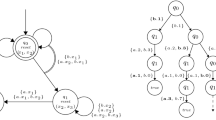Conclusion
The method of testing satisfiability of a formula of the form∨tF(t) represented as a set of right-normalized disjuncts has been implemented by a resolution procedure in a system of verificational design of automata. The use of the set of integers as the interpretation domain for the specification language has enabled us to consider only resolving by atoms of rank 0, which substantially increases the efficiency of the procedure: contrary to the traditional version, there is no need for matching and the number of resolvents is reduced. The proposed procedure has been implemented using the level-saturation method and the erasure strategy [4].
Similar content being viewed by others
References
A. N. Chebotarev, “An approach to functional specification of automaton systems. I”, Kibern. Sist. Analiz, No. 3, 31–32 (1993).
A. N. Chebotarev, “An approach to functional specification of automaton systems. II”, Kibern. Sist. Analiz, No 4, 3–14 (1993).
A. N. Chebotarev, “An approach to functional specification of automaton systems. III,” Kibern. Sist. Analiz, No. 5, 3–17 (1993).
C.-L. Chang and R. Lee, Symbolic Logic and Mechanical Theorem Proving, Academic Press, New York (1973).
Additional information
Translated from Kibernetika i Sistemnyi Analiz, No. 3, pp. 3–11, May–June, 1994.
Rights and permissions
About this article
Cite this article
Chebotarev, A.N. Consistency test for simple specifications of automaton systems. Cybern Syst Anal 30, 317–322 (1994). https://doi.org/10.1007/BF02366466
Received:
Issue Date:
DOI: https://doi.org/10.1007/BF02366466




